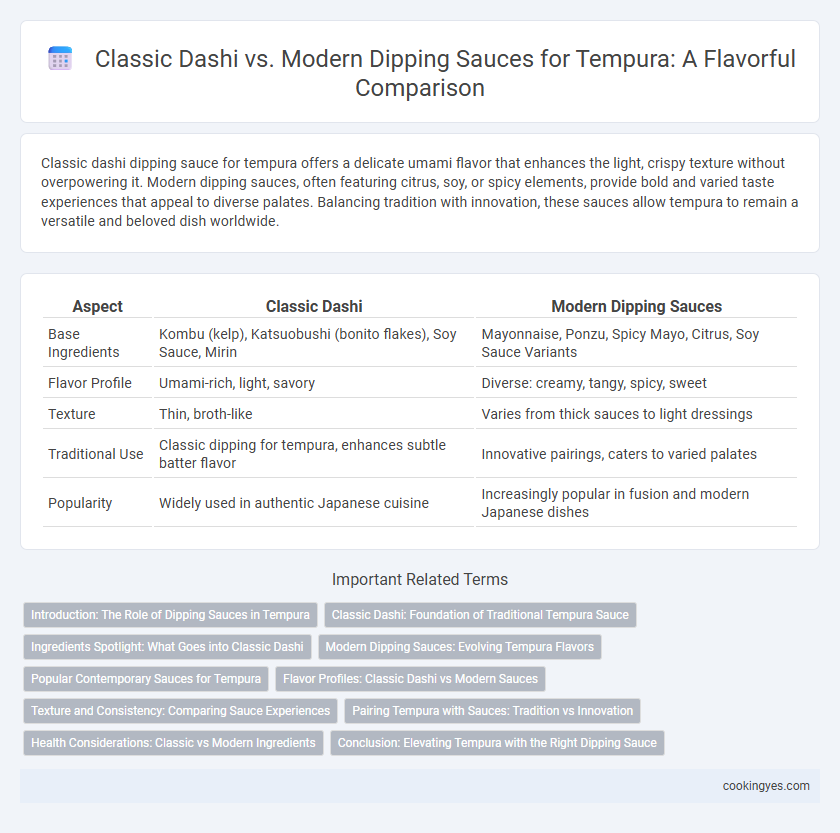Classic dashi dipping sauce for tempura offers a delicate umami flavor that enhances the light, crispy texture without overpowering it. Modern dipping sauces, often featuring citrus, soy, or spicy elements, provide bold and varied taste experiences that appeal to diverse palates. Balancing tradition with innovation, these sauces allow tempura to remain a versatile and beloved dish worldwide.
Table of Comparison
| Aspect | Classic Dashi | Modern Dipping Sauces |
|---|---|---|
| Base Ingredients | Kombu (kelp), Katsuobushi (bonito flakes), Soy Sauce, Mirin | Mayonnaise, Ponzu, Spicy Mayo, Citrus, Soy Sauce Variants |
| Flavor Profile | Umami-rich, light, savory | Diverse: creamy, tangy, spicy, sweet |
| Texture | Thin, broth-like | Varies from thick sauces to light dressings |
| Traditional Use | Classic dipping for tempura, enhances subtle batter flavor | Innovative pairings, caters to varied palates |
| Popularity | Widely used in authentic Japanese cuisine | Increasingly popular in fusion and modern Japanese dishes |
Introduction: The Role of Dipping Sauces in Tempura
Dashi-based dipping sauces for tempura emphasize umami-rich, subtly smoky flavors derived from kombu and katsuobushi, enhancing the delicate crispiness without overpowering the seafood or vegetables. Modern dipping sauces often introduce innovative ingredients such as citrus yuzu, soy variations, or spicy elements that cater to evolving taste preferences and add complexity. The choice of dipping sauce plays a crucial role in balancing texture and flavor, shaping the overall dining experience in traditional and contemporary tempura dishes.
Classic Dashi: Foundation of Traditional Tempura Sauce
Classic dashi forms the essential base of traditional tempura sauce, combining umami-rich kombu seaweed and dried bonito flakes to create a delicate, savory flavor profile that enhances the light, crispy texture of tempura. This foundational broth is lightly seasoned with soy sauce and mirin, preserving tempura's authentic taste while providing a subtle balance of saltiness and sweetness. The pure, clean essence of dashi emphasizes the natural flavors of the fresh ingredients, distinguishing it from modern dipping sauces that often incorporate heavier, more complex elements.
Ingredients Spotlight: What Goes into Classic Dashi
Classic dashi for tempura is a delicate broth primarily made from kombu (kelp) and katsuobushi (bonito flakes), providing a subtle umami depth that enhances the light, crispy texture of the batter. This traditional base relies on minimal seasoning, often just a touch of soy sauce and mirin, to maintain balance and let the natural flavors of the ingredients shine. Modern dipping sauces for tempura may incorporate stronger elements like citrus, garlic, or chili, but classic dashi remains cherished for its pure, refined simplicity rooted in Japanese culinary tradition.
Modern Dipping Sauces: Evolving Tempura Flavors
Modern dipping sauces for tempura are expanding beyond the classic dashi-based tentsuyu, incorporating diverse ingredients like citrus yuzu, soy, and spicy chili to create bold, layered flavors. Innovative blends of ponzu and wasabi offer a refreshing zest that complements tempura's crisp texture while enhancing umami depth. These evolving sauces cater to contemporary palates seeking fusion tastes, making tempura more versatile and globally appealing.
Popular Contemporary Sauces for Tempura
Popular contemporary sauces for tempura include ponzu, a citrus-based soy sauce that adds a tangy flavor, and wasabi mayo, which introduces a creamy, spicy twist. Sweet chili sauce and garlic aioli have gained traction as fusion options, providing a blend of sweetness and zest that complements tempura's crispy texture. These modern alternatives enhance the traditional tempura experience by offering bold, innovative flavor profiles beyond the classic dashi-based dipping sauce.
Flavor Profiles: Classic Dashi vs Modern Sauces
Classic dashi dipping sauce for tempura features a delicate umami flavor derived from kombu seaweed and bonito flakes, offering a subtle, savory complement that enhances the tempura's light crispness. Modern dipping sauces often combine soy sauce bases with citrus elements, chili, or garlic, delivering bold, tangy, and sometimes spicy profiles that contrast the fried texture. Both options highlight different aspects of tempura, with dashi emphasizing traditional harmony and modern sauces providing innovative, vibrant flavor experiences.
Texture and Consistency: Comparing Sauce Experiences
Classic dashi-based tempura dipping sauce offers a light, thin consistency that enhances the crispy texture of tempura without overpowering its delicate flavors. Modern dipping sauces often feature thicker, creamier textures or added ingredients like citrus or herbs, creating a richer, more complex mouthfeel that contrasts with the tempura's crunch. The interplay between the sauce's viscosity and tempura's crispiness profoundly influences the overall tasting experience, balancing moisture and texture in unique ways.
Pairing Tempura with Sauces: Tradition vs Innovation
Classic dashi-based dipping sauces for tempura emphasize umami-rich flavors derived from kombu and bonito flakes, perfectly complementing the light, crispy texture of traditional tempura. Modern dipping sauces incorporate diverse ingredients such as citrus yuzu, soy variations, and spicy mayo to offer innovative flavor profiles that cater to contemporary palates. Balancing the delicate tempura batter with either the subtle depth of classic dashi or the bold zest of modern sauces highlights evolving culinary trends while respecting traditional Japanese cuisine.
Health Considerations: Classic vs Modern Ingredients
Classic dashi-based tempura dipping sauces are typically made from kombu, bonito flakes, soy sauce, and mirin, offering a low-calorie and nutrient-rich option with beneficial antioxidants and amino acids. Modern dipping sauces often incorporate ingredients such as mayonnaise, creamy bases, or added sugars, which increase calorie content and may raise concerns for those limiting fat or sugar intake. Choosing classic dashi preserves the traditional umami flavor with fewer additives, supporting heart health and digestive balance compared to richer, processed alternatives.
Conclusion: Elevating Tempura with the Right Dipping Sauce
Selecting the appropriate dipping sauce is essential for elevating the delicate flavors of tempura, with classic dashi-based sauces providing a balanced umami-rich complement that enhances the batter's light crispiness. Modern dipping sauces, often infused with innovative ingredients like yuzu or soy-based blends, introduce bold and refreshing contrasts that cater to contemporary palates. Mastery of pairing tempura with either traditional or modern sauces ultimately transforms this Japanese dish into a versatile culinary experience.
Classic dashi vs modern dipping sauces for tempura Infographic

 cookingyes.com
cookingyes.com